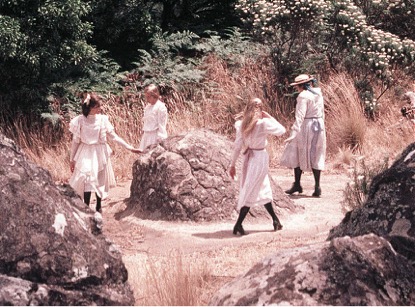Written by Elizabeth Heffernan, RAHS Volunteer
On Valentine’s Day in 1900, two schoolgirls and their maths teacher went missing from a picnic at Hanging Rock and were never seen again – or so author Joan Lindsay led her readers to believe in the classic Australian novel Picnic at Hanging Rock, first published in 1967. A short note from the author prefaces the story: “Whether Picnic at Hanging Rock is fact or fiction, my readers must decide for themselves. As the fateful picnic took place in the year nineteen hundred, and all the characters who appear in this book are long since dead, it hardly seems important.” [1]

[IMAGE COURTESY NATIONAL FILM & SOUND ARCHIVE, 1408814]
The Hanging Rock itself and the featured town of Woodend in the novel are real, located in the Victorian Macedon Ranges on the land of the Wurundjeri, Taungurong, and Dja Dja Wurrung people of the Kulin nation. [5] Appleyard College was likely based on the school Lindsay attended as a young girl. Yet Lindsay’s school was in East St. Kilda, and did not relocate to the Macedon region until 1919. Valentine’s Day in 1900 did not fall on a Saturday, as the novel claims, but midweek. Local newspapers never reported such a mysterious incident in their pages. [6] An unreleased chapter of the novel scrapped by Lindsay before publication suggested that the girls disappeared into another dimension. Clearly, Picnic is a work of fiction. Its fictitious nature, however, does not deprive the novel of meaning. Indeed, fictional or not, Picnic at Hanging Rock has become a work of historical importance in its own right. The novel was one of the first Australian works to join the Gothic literary genre. Weir’s film adaption became Australia’s greatest international success at the time and today remains a cult classic as an early example of Australian New Wave cinema.
Fifty-two years of theories, controversies, and anniversary reprints have ensured the novel remains relevant to a twenty-first century audience. Though the story may indeed be a product of Lindsay’s imagination, it remains a vibrant part of Australia’s cultural history – so this Valentine’s Day, why not find yourself a copy, rent Weir’s film, and be drawn into the mystery from the very first line: “Everyone agreed that the day was just right for the picnic to Hanging Rock.” [7]
References:
[1] Lindsay Joan, Picnic at Hanging Rock, (Sydney: Penguin Books, 1975).
[2] ‘Picnic tragedy: true or false?’, The Canberra Times, 17 November 1975.
[3] ‘You wanted to know with Kevin Schluter’, The Australian Women’s Weekly, 15 July 1981.
[4] Chris Conti, ‘Did it Really Happen? Picnic at Hanging Rock‘, Sydney Review of Books , 29 September 2017, <https://sydneyreviewofbooks.com/essays/did-it-really-happen-picnic-at-hanging-rock>, viewed 21 October 2024.
[5] Amy Spiers, ‘What really happened at Hanging Rock’ Vice, 3 February 2017, <https://www.vice.com/en_au/article/qkzzzv/what-really-happened-at-hanging-rock>, viewed 14 February 2019.
[6] ‘Picnic tragedy’, The Canberra Times.
[7] Lindsay, Picnic at Hanging Rock.

0 Comments